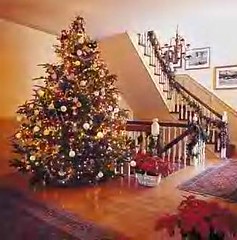
Gentle Reader,
With lights stretched from high to low, ornaments scattered in hopeless array, and the smell of apple cider boiling somewhere near, the timely event of winter decoration sets the tone of our December. Until the house is fully lit up, somehow it just doesn't seem quite like the season has started. Like a Thanksgiving without pumpkin pie or a birthday without candles, some of our most precious traditions can be the simplest pleasures of a momentary occasion soon to pass. At the center of our common tradition are the Christmas trees that find themselves adorned with silver, laced with tinsel, covered in lights, and crowned with a star. During the late 13th Century, Thomas de Hales wrote a lengthy poem in Old English called A Luve Ron (A Love Song). During one of the stanzas, he referred to a "treowe king" by which he meant, "a true king." The word treowe took two different directions from the time of Hales to later scholars like Wycliffe and Tyndale (16th Century). Over a period of just 300 years, treowe became closely associated with both "true" and "tree" because in either case, it continued to mean someone or something that would not fall. A tree firmly rooted will never tumble unless broken by the axe. Greeks referred to their trees as xylon (think of the "wood" sound of a xylophone) while the Romans referred to them as arbor in Latin (think "Arbor Day" and the tradition of planting seeds). Trees have always symbolized a practical and essential part of sturdy construction, but the fir and pine trees are uniquely mentioned during the Scripture of Isaiah 60:13. "The glory of Lebanon shall come unto thee, the fir tree, the pine tree, and the box together, to beautify the place of my sanctuary; and I will make the place of my feet glorious." Although we find that many planters now grow the fir and pine on a farm, the natural pine grows on the mountainside. In fact, it is the fir and evergreen tree that adorns the forest of these "beautified" mountains. And when the snow comes falling, every needle and every cone is covered in white by the decoration of God's design. The history of our modern Christmas tree can be traced back to the hills of Germany and the hero of the reformation. At various times during the winter, Martin Luther was known to take a small spruce tree and decorate it with candles as a symbol of the sparkling stars in heaven above. When German immigration began to increase on American soil in the 1830s (more than 300 years after Luther), English Protestants were initially frightened by what they perceived to be a very pagan tradition among professing Christians. But by 1838, just 32 years before President Grant declared Christmas to be a national holiday, the word "Christmas tree" had already become commonplace. Some of you will share legitimate concern for the practice and decoration of trees (Jeremiah 10:2-4) while others will view it as a harmless activity in the age of God's grace. Whether you enjoy the smell of fresh pine in your living room or prefer to avoid it altogether, may you find that the season is no less inviting for the family you love and the fires that you build.



No comments:
Post a Comment